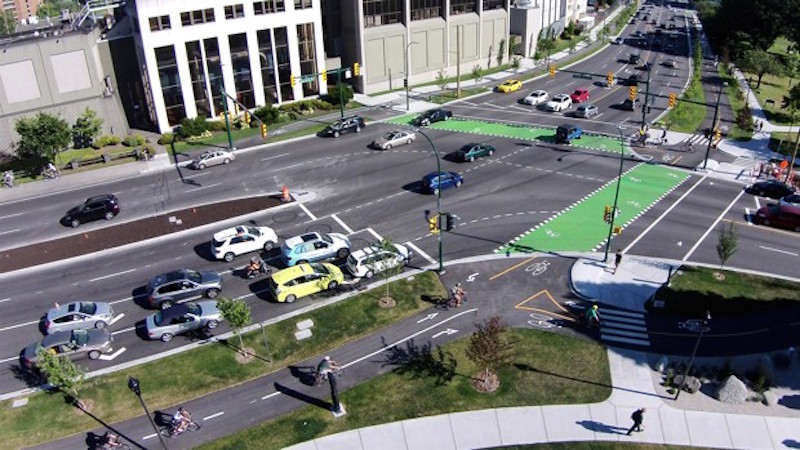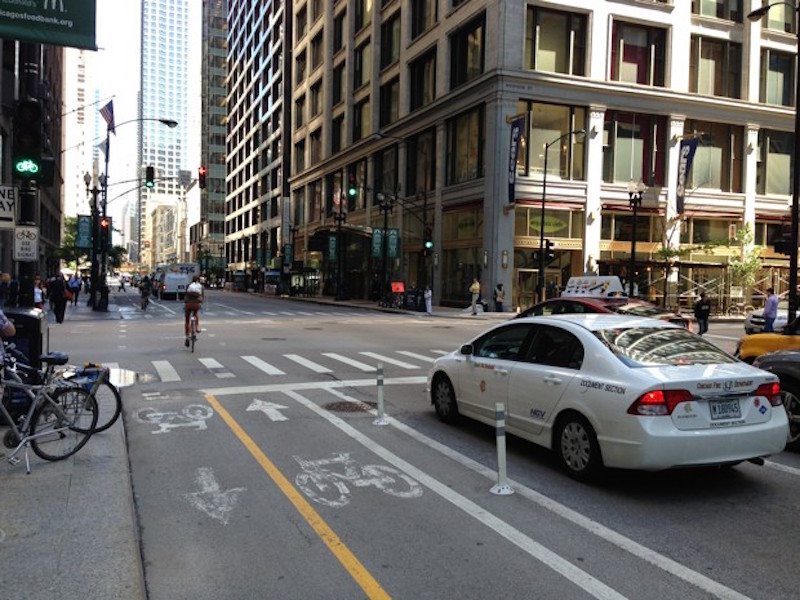Researchers at Portland State hope to be the first to develop standard guidelines for protected bike lane crossings.

More than 125 years after their earliest appearances, bike lane designs can still be surprisingly arbitrary.
Nowhere is this clearer than with protected bike lanes, those cycling pathways that are separated from cars by some type of physical barrier, such as planters, curbs, parked cars or posts. Protected lanes are considered the gold standard for cyclist safety and comfort, but in most of the world, how and if they’re implemented at all is largely up to local jurisdictions. Even where protected lanes are in place, when they meet up with busy intersections, those protections typically go away, and the logic behind their design can quickly fall apart.
Some North American cities have installed what’s known as “protected intersections” (also referred to as the “Dutch approach”—pictured at top in Vancouver) which maintain lane separation through intersections via the use of concrete islands. Much more common are “mixing zones,” where cyclists must briefly share space with cars. And then there are intersections that use special signal timing to help keep people on bikes somewhat more separated from auto traffic.

Will more widespread standards for bike lane treatment at intersections ever emerge in the U.S.? The Transportation Research and Education Center at Portland State University aims to move that conversation forward with its newest study. Using pooled funds from 11 counties, regional planning bodies, transit agencies and nonprofits around the country, researchers at Portland State will first create an inventory of all sorts of intersection treatments. Then they’ll use computer simulations, video analysis, and cyclist surveys to determine the “critical thresholds that designers need to consider from one design to another,” says Christopher Monsere, a professor of civil engineering at Portland State and the project’s lead researcher.
From our partners:
What are those thresholds likely to be based on? “The volume of different traffic streams will be a key metric, as a way to estimate bike and car conflicts,” says Monsere. “Speed will also be a design variable we look at because it influences both severity of conflicts and how much visibility you need to provide for cyclists using a protected bike lane.” He and a team of researchers will look at how each design affects right and left turning, and how useful they are on different types of streets.

The 11 partnering agencies are eager for data-backed guidance. One of them, Cambridge, Massachusetts, is home to some of the earliest separated bike lanes in the country. But as Cara Seiderman, the city’s transportation program manager, put it in a statement, “We’ve been using our best engineering judgment, and the best practices that exist. And we realized that that could be even stronger.”
Portland’s own regional transit authority, TriMet, is another partner. Jeff Owen, a transportation planner for TriMet, says he’ll be looking for ways to ensure that buses can get to stops along protected bike lane intersections. “This is an attempt to make sure we’re part of the conversation,” Owen said in a statement.
Within the next 18 months, TREC researchers and a design group plan to produce a standard tool that any transportation agency can use. The hope is that those agencies will translate the findings into safer, more useful infrastructure for cyclists and drivers alike.
This feature originally appeared in Citylab.

















